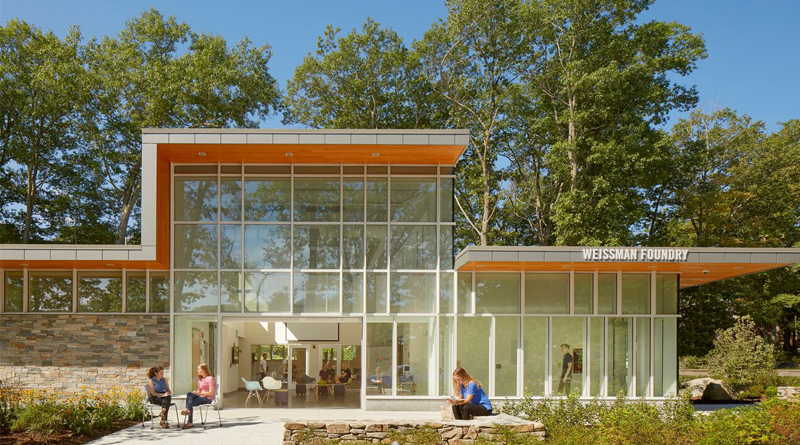Q&A: Windover Construction Completes Babson College’s New Academic Center
By Roxanne Squires
BABSON PARK, Mass. –– Windover Construction, an award-winning construction management firm specializing in academic building, recently completed construction of the Weissman Foundry at Babson College.
The 10,000-square-foot building is Babson’s newest and most innovative academic center.
The Weissman Foundry is an open-door design studio inspiring transdisciplinary innovative collaboration between Babson, Olin and Wellesley students for the advancement of new or existing projects. It was made for the curious — the entrepreneurs, engineers, artists, and academics alike. Designed as an intentional mashup of student interests, the Weissman Foundry is meant to ignite forward-thinking idea exploration, iteration, and design, and to facilitate meaningful knowledge transfer between the three college communities.
School Construction News spoke with Randy Catlin, EVP & COO of Windover Construction, to discuss the project.
Q: When did construction begin and when was it completed? Architectural firm/general contractor?
Catlin: Construction began in January of 2018 and was completed in August of 2018.
Builder: Windover Construction
Mechanical Engineer: Vanderweil Engineers
Architect: William Rawn Associates
Structural Engineer: LeMessurier
Q: What was the overall goal of this construction project?
Catlin: The overall goal of this project was to create a 10,000-square-foot open-door design studio to inspire transdisciplinary innovative collaboration between Babson, Olin, and Wellesley college students for the advancement of new or existing projects! It was made for the curious—the entrepreneurs, engineers, artists, and academics alike. Designed as an intentional mashup of student interests, the Weissman Foundry is meant to ignite forward-thinking idea exploration, iteration, and design, and to facilitate meaningful knowledge transfer between the three college communities.
Windover led the preconstruction and construction and collaborated with the design team to execute Babson’s vision for the advanced facility. Featuring areas for project work, large and small, this new creative space provides access to workbenches, advanced fabrication equipment, traditional tools, robotics, AR/VR, and sought-after connections to expertise and training.
Q: What are the major design elements/features? (Sustainable, if any?) How will this design influence/improve the student learning/teaching environment?
Catlin: The facility features several complex and contemporary design elements. With meticulous upfront preconstruction planning, Windover prepared for the successful build of these elements despite facing a condensed, eight-month construction schedule. The stunning building envelope, consisting of the convergence of curtainwall, masonry, and metal panel at every elevation with dramatic wood canopies, required tight coordination across multiple trades to execute.
Interiorly, the space features polished concrete floors, open and connected spaces divided by louver-operated doors, wood slat ceiling accents, exposed ductwork, and moveable furniture, fixtures, and worksurfaces all contributing to the flexibility and utility of the space. As the name “Foundry” suggests, it is an industrial concept tempered by contemporary, stunning design features.
Set within a wooded landscape, the industrial-looking Foundry has abundant natural light, wood canopies, and a “living roof” that supports the college’s sustainability commitment and is registered with the certification goal of LEED® Silver. The facility also incorporates high-performance MEP systems, including a custom energy recovery unit.
Through these unique design elements, students and teachers alike enjoy a versatile and open environment that ignites forward-thinking idea exploration, iteration, and design, and knowledge transfer. The Foundry is a place for learning and hands-on experimentation.
Q: How does this project follow other national school construction trends? What is unique about this project compared to other school construction trends?
Catlin: For many years now, the trend of experiential and transdisciplinary education has continued to grow and shape the way academic campuses are looking at their academic buildings and spaces. Learning environments are becoming more flexible, adaptable and integrated in response to this trend with buildings dedicated to STEM, STEAM, and STREM curriculums. With a focus on hands-on and collaborative learning, traditional classrooms are transforming into open-concept spaces with moveable furniture and makerspaces, and academic buildings are now being designed and programmed to host multiple disciplines under one roof.
Unlike STEM, STEAM, and STREAM buildings which are dedicated to select disciplines, the Weissman Foundry was intentionally designed to support a mash-up of student interests and a diverse spectrum of entrepreneurs, artists, engineers, and academics alike. Through experiential and transdisciplinary approaches, the Foundry is a place that equips students to use their collective business, engineering, and liberal arts educations to create impactful social and economic value everywhere.
Q: Are there any innovative technological/electronic systems or solutions integrated into this new facility?
Caitlin: Yes. Due to the unique industrial and open design, Windover facilitated the intricate MEP/HVAC infrastructure, including moveable fixtures, high power loads, and complex ductwork connections. All of this was made possible by using 3D BIM coordination and prefabrication of selected elements.

